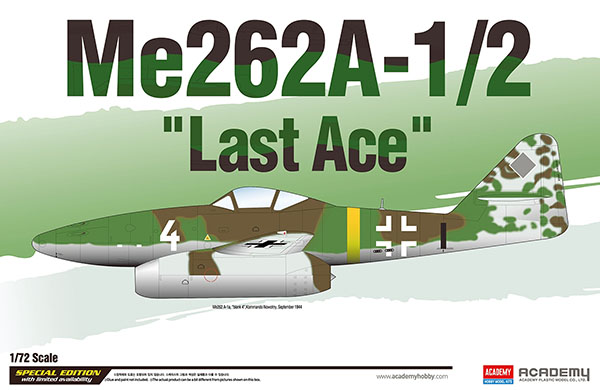
Academy 1/72 Messerschmitt Me 262A-1a/2a
By Chris Banyai-Riepl
Overview
When it comes to World War Two Luftwaffe aircraft, while the Bf 109 and Fw 190 are at the top of the list, it's very likely coming in third in popularity is the Messerschmitt Me 262. As the world's first operational jet fighter, it has captured the imaginations of aviation enthusiasts for decades. As a result of this interest, there are untold numbers of books and websites devoted to this famous twin-engined jet. Rather than pen up a comprehensive history of the plane here that would still be a shadow of this previous research, I recommend checking out any number of quality references out there in print or online.
The Kit
The Academy 1/72 Messerschmitt Me 262 kit is currently the best choice for a Me 262 in this scale, having overall more detail and better shape than the competition. Featuring recessed panel lines throughout, a detailed interior, and options to build different variants, this kit will build up into an impressive Me 262 out of the box. The decal choices add even more, with five options provided.
Assembly starts with getting the forward fuselage assembly together. This begins with putting together the nose wheel well, which is then sandwiched between the fuselage halves. The gun troughs are molded in a separate piece, and there are two options to choose from. The instructions indicate to place weight under this piece before affixing it, and given the tail-heavy situation, you'd best not forget this part.
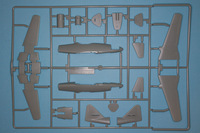
|
Once the forward fuselage is done, attention can turn to the cockpit. This is a complex assembly as it also includes the main wheel well interior structure. There is a cockpit tub that gets a separate seat, rudder pedals and control column, and this assembly then fits into another tub that makes up the main wheel well interior. This is a nice way to do things as it makes it easier to paint both the cockpit and the wheel well, while also maintaining the maximum amount of detail.
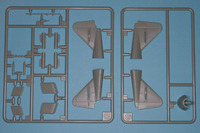
|
With the forward fuselage together, the next step is to build the rear fuselage. There are two different tail assemblies provided, one for the Me 262A-1a and one for the Me 262A-2a. The main difference is with the rudder, with the A-2a version having a separate lower piece. Whichever option you choose, the main assembly is made up of right and left halves, with separate stabilizers. While the instructions have you fit these parts on now, it might be easier and give better alignment if you add the front and rear sides together before joining the right and left halves. Experiment with dry fitting before gluing any of the fuselage together to see which works best for you.
The wings are straightforward, with a one-piece lower wing taking on separate right and left upper pieces. There are some additional main wheel well details added as well. The engines are simple, with right and left halves getting a one-piece intake cone. The rear exhaust has the complex bulb fairing made up from right and left halves, which then fits onto a disc to fit in between the nacelle halves. A similar disc provides the intake face. Once the engines are together, they can be added to the wings.
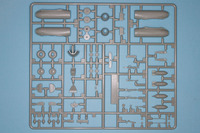
|
The remaining assembly is all the small bits. The main gear has three-piece wheels and a single strut, with three separate wheel doors for each side. Also on the underside, there are several armament options, including R4M rockets under the wings and either bombs or rockets under the forward fuselage. The canopy can be positioned open or closed, and the last bits are the various antennae found around the airframe.
Decal options are interesting in this release, with five aircraft covered. The first three are Me 262A-1as, and first up is White 4 of Kommando Nowotny in September 1944. This plane features a simple camouflage of RLM 81/83 over RLM 76 with light mottling on the vertical fin. The second choice is White 17, flown by Heinz Bär and captured at Lechfeld in April 1945. Also finished in RLM 81/83 over 76, this plane features mottling along the fuselage sides as well as the tail. The nose and front end of one of the engines is in natural metal. The third Me 262A-1a is Adolf Galland's White 3 of JV 44 in April 1945. This plane features a more densely mottled camouflage on the fuselage sides in 81/83/76.
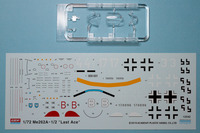
|
For the remaining two options, these are Me 262A-2a aircraft, the first of which is 9K+BN from 5./KG(J) 51 "Edelweiss" in December 1944. This plane has a non-standard RLM 81/83 camouflage over RLM 76, with RLM 76 squiggles all over the upper surface of the aircraft. The second Me 262A-2a is 9K+BH from 1./KG 51 in September 1944. This plane also has a non-standard camouflage consisting of RLM 83 uppers with dense RLM 81 mottling, all over RLM 76. All of the schemes are nicely represented in the decals, with crisp registration and lots of stenciling.
Conclusion
With all the options provided in the kit, along with the nice out-of-the-box detailing, this remains the kit to have if you want to build a 1/72 Me 262, and this latest release provides some interesting markings to boot. My thanks to MRC for the review copy.
